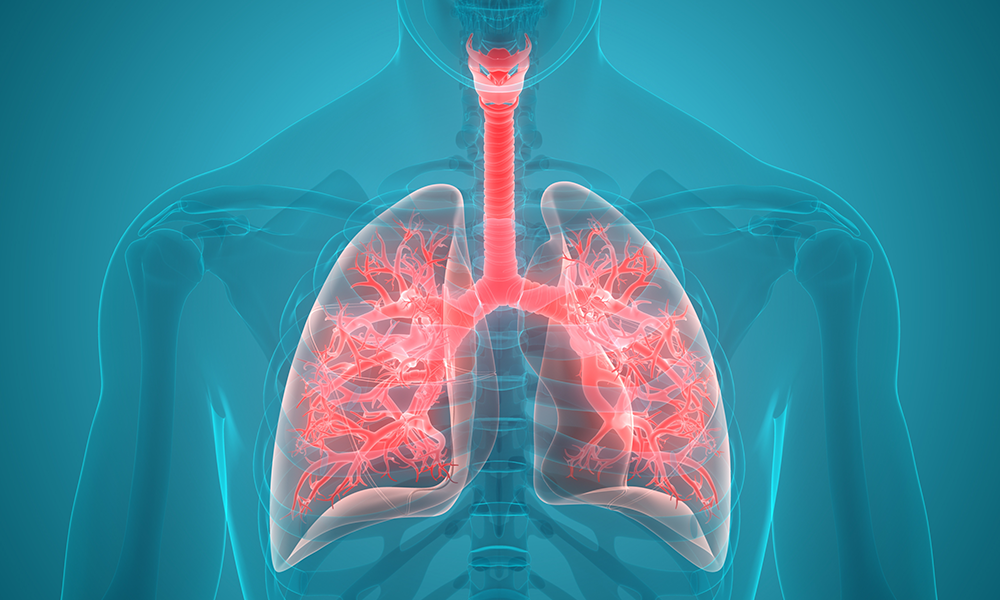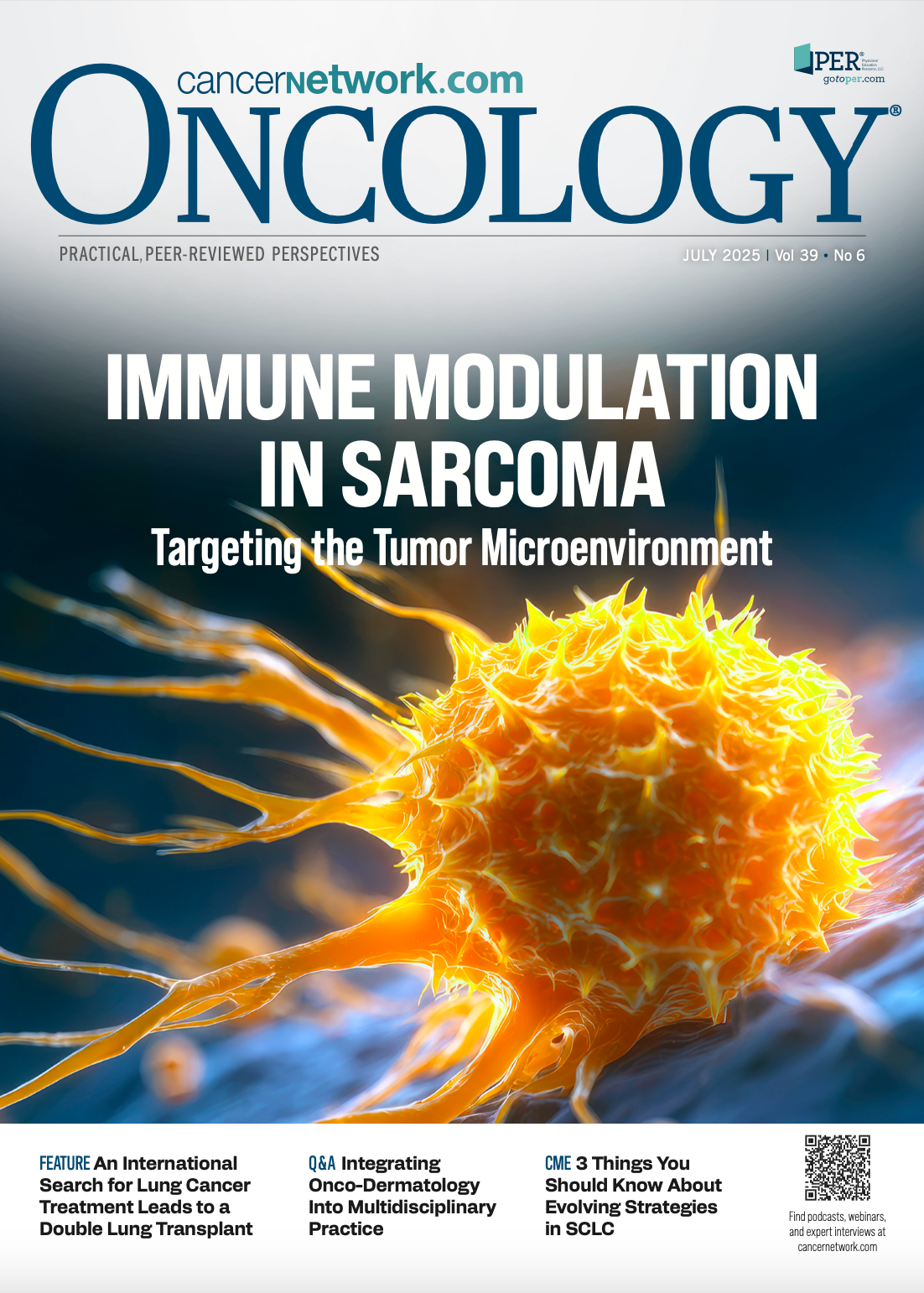An International Search for Lung Cancer Treatment Leads to Double Lung Transplant
The DREAM program led by Ankit Bharat, MD, MBBS, FACS, allowed Cornelia Tischmacher to receive a double lung transplant for her stage IV lung cancer.
“I knew that [stage IV] sounds [uncurable]. At this point, one is still only interested in cures. I did not want to hear any stories about living with cancer. I thought, ‘No, I’m not living with cancer. I’m going to defeat it,’” Cornelia Tischmacher, stage IV lung survivor, said in an interview with CancerNetwork®.

Initially beginning as bouts of pneumonia, Cornelia Tischmacher was shocked to discover that the recurring ailment was revealed to have been caused by stage III cancer after a diagnosis in January 2018. Tischmacher, then 40 years old, was a nonsmoker who worked out and led a busy lifestyle as a Berlin-based art historian and gallerist.1
“When I finally found out that it was cancer, it was a huge shock. It was maybe the only time in my life I screamed at the top of my lungs. In the beginning, I thought, ‘Let’s treat it like any other disease. Let’s do what needs to be done, and then hopefully I can check it off,’” Tischmacher said during an interview with CancerNetwork®. “I knew that [stage III] sounds [uncurable]. At this point, one is still only interested in cures. I did not want to hear any stories about living with cancer. I thought, ‘No, I’m not living with cancer. I’m going to defeat it.’”
Following treatment in 2018, which consisted of surgery and chemotherapy, and included the removal of approximately 30 lymph nodes, by October 2019, the cancer had recurred. Aware of transplantation as an option, Tischmacher was initially dissuaded due to the relative infrequency of transplantation surgery in Europe, due to immunosuppression-related concerns. Continuing palliative care, she explored options for potentially lifesaving treatment modalities and came across a clinical trial ongoing in Chicago that might have offered the treatment she needed.
Offered as a last resort to patients who have exhausted all other therapeutic options, the Double lung transplant REgistry Aimed for lung-limited Malignancies (DREAM) program (NCT05671887), led by Ankit Bharat, MD, MBBS, FACS, chief of Thoracic Surgery in the Department of Surgery, Harold L. and Margaret N. Method Professor of Surgery, and professor of Pulmonary and Critical Care at Northwestern Medicine Feinberg School of Medicine, offers double lung transplantation for patients with advanced lung cancers.
“When I first read on ClinicalTrials.gov...in May 2023, that there was a trial out there for people who have cancer confined to the lungs, I was amazed, because I, not knowing anything more about it, at least felt like I had a chance there,” she expressed.
By June 2024, when breathing required the use of supplemental oxygen, she had undergone the process for enrollment in Northwestern’s DREAM program, following efforts to organize her living situation, and caregivers for herself and her children. Months later, in December, she had arrived in Chicago by ambulance flight, not commercial airline, due to the high oxygen levels she required to breathe.
Following her arrival on December 9, 2024, she was accepted for trial enrollment on December 24 and by December 26, she had received word that a matching organ was available for her and that she could undergo surgery.
“That day was already for me actually the easiest in years. I had no doubt going into the surgery that they would do nothing but a perfect job, because I had read about it, and I knew that they had great [outcomes]. They’ve done more [lung transplants] than anyone, probably in the world,” she stated. “Compared with Germany, for example, in Berlin, I found out they do less than 20 lung transplants a year. The whole technique is unknown in Germany, and I was excited. It felt like winning the lottery.”
The DREAM Program
Bharat expressed that Cornelia, like other patients with stage IV lung cancer, arrived at Northwestern, had severely impaired respiratory function.
“[Patients like Cornelia] are quite sick because they have stage IV cancer. They’ve gone through lots of different treatments, chemotherapies, immunotherapies, surgeries, [and] radiation––so [they are] not only dealing with a catastrophic disease, but they also have gone through many treatments that are [quite] toxic or [takes] a toll on their body,” he explained in a conversation with CancerNetwork. “Often, these patients then progress to developing respiratory failure, because the cancer has progressed so much in the lungs that they cannot even breathe.”
The DREAM program itself is an observational study where clinicians perform double lung transplantations to patients with advanced lung cancers not amenable to treatment with systemic therapy or for those who were cured of cancer within 5 years, but who are experiencing lung failure and do not meet traditional criteria for lung transplantation.2
Inspired by COVID-19 lung transplantation techniques, the procedure was developed as a means of minimizing the risk of cancer spreading to newly transplanted lungs. As of May 11, 2025, more than 50 lung transplants have been performed by Northwestern Medicine surgeons for patients with advanced lung cancers.
Despite the risks of a complex and technically challenging surgery, Bharat stated that many patients still elect to undergo the surgery. Furthermore, he iterated that Northwestern surgeons have a high level of experience and that treatment-related fatalities are low for those who undergo the procedure.
“Lung transplant is one of the most complex surgeries we can do. Obviously, there is a certain risk [associated with the procedure]. We talk about those with the patient,” he remarked. “Fortunately, at Northwestern we have [surgeons with a] very high level of experience…patients don’t die on the table or early on, they don’t have catastrophic surgery-related complications.”
Managing Immunosuppression and Chronic Lung Rejection
Although the procedure is feasible and has a relatively low recurrence rate, medications that are taken as maintenance to combat immunosuppression following the procedure have adverse effects (AEs). Additionally, according to Bharat, longer-term concerns correlating with the use of these medications can cause chronic lung rejection-related AEs, including kidney, immune system, and bone marrow damage. Cornelia described her first few months on maintenance therapy as difficult, particularly regarding hematologic AEs.
“Especially in the first months, the medication is difficult to take. It’s a bit like chemotherapy. It was explained to me like that because a lot of the medication inflicts problems on your blood count,” she said. “For example, I [had] intense neutropenia, so I [had] to get these shots against it, but it didn’t quite work. You always find out things you have to do. Sometimes you have [variation in] tacrolimus levels. There’s a lot of time involved and trial and error until you find a happy balance.”
Additionally, compliance with medication can significantly impact a patient’s outcomes post surgery. Bharat expressed that higher compliance rates may correlate with better long-term outcomes for those who have successfully completed a double lung transplantation.
“What we do [at Northwestern] is thoroughly counsel patients and [ensure] that they are being compliant with the medications,” he explained. “Those complications do tend to occur more commonly [with less compliance], meaning some days you may take too much, some days you're taking less. Being consistent reduces the risk [of complication]. We closely monitor in case you see signs of some complications or AEs developing, we change the strategy so we can avoid that.”
Quality of Life Considerations Following Double Lung Transplantation
Following the receipt of her new lungs, Cornelia claimed to feel the difference immediately.
“I remember waking up and thinking, ‘Wow, it's much better than anyone explained to me.’ I immediately felt OK…you can tell, even if you have a breathing tube, that breathing is possible. That’s a new feeling,” she explained.
Cornelia described how her quality of life improved following the procedure, beginning with a discharge 1 week after the transplantation. Initially unable to even stand, Cornelia outlined her journey in regaining functionality of her body in the months after she received her new lungs.
“In the beginning, I couldn’t even stand. You learn it’s incredibly hard work to get back [into shape],” Cornelia expressed. “Every day I’m in rehab or I'm in the gym. I try not to walk less than 10,000 steps a day, because it makes a difference.”
For Cornelia, although it has been an adjustment, it gives her the opportunity to focus on herself and live cleanly for her health.
“I am reminded every now and then that you have to change your lifestyle completely. You don’t drink. The great thing about it is that the medication teaches you, because if you are eating the wrong food––you are only supposed to eat lean proteins, no fats, and so on––if you go against the rules, you immediately get sick,” she expressed. “In a way, it’s a relief. It’s clear you must live a very clean life now, which is easy in my situation right now, where I can concentrate on myself.”
Despite the lifestyle constraints and the ongoing physical therapy, Cornelia said that she can keep herself preoccupied. She has been medically advised to remain in Chicago to be close to the Shirley Ryan AbilityLab, where she has been receiving outpatient rehabilitation, and to the Feinberg School of Medicine, where she receives posttransplant monitoring. Following a suggestion from a treating clinician, she has been spending her time in Chicago, "reading, writing, and thinking," while taking some time to venture out and explore the regional art scene.
“It's always interesting to find out what curators do here, what the art market looks like,” she remarked. “At least, I’m not bored here.”
Bharat, who regularly sees Cornelia during follow-up, described Cornelia’s recovery journey as "spectacular," contrasting her initial state battling with failing lungs, to someone who you may not have even assumed is a stage IV lung cancer survivor.
“I saw her today. She was looking unrecognizable.… full of color and energy. She [looks] completely normal as someone who didn’t go through any [surgery],” he explained. “She’s reunited with her family, 2 young kids, and her husband. She’s…doing normal day-to-day activities. It’s been great.”
He further expressed that his team continues to track her for recurrence using CT and PET scans, as well as bronchoscopy to help identify early recurrence. Notably, his team also developed a customized test based on the genetic profile of the removed cancer to identify early recurrence through the DNA in her blood.
“So far, after multiple months of testing, there’s no evidence of recurrence,” he concluded.
Highlighting a Story of Resilience
When asked if he would like to highlight anything regarding his experience treating Cornelia, Bharat suggested that patients may benefit by proactively seeking alternative treatments for chronic or late-stage cancers, even after they have exhausted all other options at their local centers.
“In Cornelia’s case, she was told nothing further could be done, but she searched and found us across international lines. That’s the reason she’s alive today,” he stated. “Patients have to take that in their own hands and take some time to seek more information, particularly when it comes to a lifesaving [procedure].”
For Cornelia, she’s grateful to have undergone the procedure and is fortunate to have qualified.
“You get very humble…there [could have been] one attribute that I had that would have excluded me from this [treatment],” she explained. “I felt for my kids, I had to survive. [When] I left Germany [I told them], ‘I'm going to America. There is someone who might be able to help me. It will probably take a long time.’ But they were thinking, “Of course, she's coming back.’ And I thought, ‘Oh, please.’ But then once I was in that OR, I thought that this was going to work out.”
References
- Mother of twins travels from Germany to Chicago for life-saving lung transplant after being diagnosed with terminal lung cancer. News release. Northwestern Medicine. May 11, 2025. Accessed May 29, 2025. https://tinyurl.com/3y9bphs3
- DREAM Program. Northwestern Medicine. Accessed May 29, 2025. https://tinyurl.com/5n7vpe8b
